The ABCs of Starting a Linen Collection
The basics of investing in the ultimate linen stash, and making it last.
Published May 17, 2017 11:00 AM
We may earn revenue from the products available on this page and participate in affiliate programs.
For someone who’s looking to build their linen collection, where is the best place to start?
I would always start with the napkins. Linen napkins feel luxurious and serve a very definite function. If your table is handsome enough to stand alone, you might not need a tablecloth at all!
What are the core elements of a linen collection, with entertaining in mind?
Napkins are a must, of course. A set of eight or more linen napkins is a good start, even if you have place settings for fewer. It’s a good idea to have a few extras on hand, even though linen is a very forgiving fabric. Cocktail napkins are pretty and useful if you have appetizers, and can even serve as coasters!
For a more formal look, consider layering cloths. The undercloth needs to be at least five inches longer than the top cloth, so it shows properly, but this is one time when you can have it hang to the floor for a formal event—just remember to sweep the corners safely in under the table, or they can become a trip hazard.
Runners are versatile and can frame your serving dishes, adding a layer of interest to the table.
It seems like most tablecloths come in a limited range of sizes. How can one work around this?
Once you have a table of the perfect size, invest in a tablecloth to fit it. Tables are not necessarily standard sizes, so always, always measure your table to be sure your cloth hangs perfectly—eight to 15 inches evenly all round. Shorter can look skimpy; longer and you risk sitting on it. Uneven just looks strange. (Psst! We are happy to make custom sizes)
What is a common misconception people may have when it comes to their entertaining linens?
That it must be ironed! The “Rough” in Rough Linen refers to the natural texture of washed linen, which catches the light beautifully. Put your cloth onto the table well ahead of time, and spray fold marks with water then smooth them out with your hands. It will dry perfectly within about twenty minutes—this works for any kind of fold or wrinkle. (Don’t do this on a French-polished table or you will spoil the finish.)
We love the variety of colors offered in the line! How would you suggest someone mix and match their linens?
Play with them! Natural and white are always classic and provide a neutral backdrop for your flowers and food. Incorporating some color with indigo or dusk napkins is festive for special occasions. Black and charcoal add a bit of drama when you want it. Another creative approach is to skew a tablecloth diagonally or set runners cross-wise. Whatever you decide, our linens are meant to provide an easy, elemental foundation—good food and good company are the stars.
What are your go-to tips and tricks for caring for linens?
Machine wash with a gentle detergent, well dissolved. Linen is easy, and “wears clean” just like wool, just keep it away from bleach and harsh products. Drying is the most important stage of linen care. Line dry or tumble on medium, but remove your linen while it is still very faintly damp, shake it out flat and let it dry naturally—it shouldn’t take more than twenty minutes, and the wrinkles will fall away, leaving the beautiful texture. Over-drying harms the fibers, and bakes wrinkles in. As with all fabrics, if you have a stain, test an inconspicuous part first if you use neat detergent or a spray—hand dish-washing detergent is safest. If you are uncertain that a stain has gone, line-dry the linen rather than tumble, as heat can set stains.
